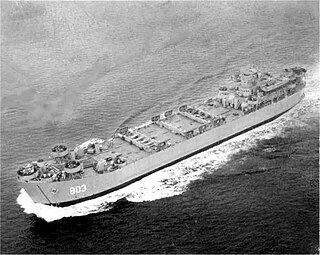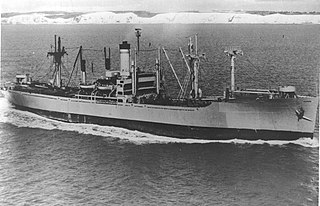
Hampden–Sydney College (H-SC) is a private liberal arts men's college in Hampden Sydney, Virginia.

HMAS Gascoyne (K354/F354/A276) was a River-class frigate that served in the Royal Australian Navy (RAN). Laid down in 1942 and commissioned in 1943, the frigate served during World War II, before being placed in reserve in 1946. Reactivated in 1959, Gascoyne was reclassified as a survey and research ship, a role she fulfilled until she was decommissioned again in 1966, and sold for scrap in 1972.

William Belser Spong Jr. was an American Democratic Party politician and a United States Senator who represented the state of Virginia from 1966 to 1973.

The USS Hampden County (LST-803) was an LST-542-class tank landing ship built for the United States Navy during World War II. Named after Hampden County, Massachusetts, she was the only U.S. Naval vessel to bear the name.

The SS William and Mary was a Victory ship built during World War II.

The SS Lindenwood Victory was a Victory-class cargo ship built during World War II. The Lindenwood Victory was a type VC2-S-AP2 victory ship built by Permanente Metals Corporation, Yard 2, of Richmond, California. The Maritime Administration cargo ship was the 766th ship built. Her keel was laid on May 12, 1945. SS Lindenwood Victory was an armed cargo ship She was built in just 70 days, under the Emergency Shipbuilding program for World War II. SS Lindenwood Victory was an armed cargo ship, named for Lindenwood University in St. Charles, Missouri, one of 150 educational institutions that had Victory ships named after them. The 10,600-ton ship was constructed for the Maritime Commission.

The SS Park Victory was a Victory-class cargo ship built during World War II under the Emergency Shipbuilding program. The ship was operated by the Seas Shipping Company. The ship launched on April 21, 1945, near the end of the war.

SS Mercer Victory was a Boulder Victory-class cargo ship built for World War II. Mercer Victory, a Victory ship, was launched 14 March 1945 by Permanente Metals Corporation, Richmond, California and operated by the States Marine Line. At the ceremonial ship launching, Mercer University President Spright Dowell said the SS Mercer Victory should strive: “to do her full-part for the national defense” and “to study a plan for after war conditions and needs.”

The SS Middlebury Victory was an American Victory-class cargo ship built during World War II. The Middlebury Victory (MCV-726), was a type VC2-S-AP2 victory ship built by Permanente Metals Corporation, Yard 2, of Richmond, California. The Maritime Administration cargo ship was the 726th ship built. Her keel was laid on December 16, 1944. The ship was christened on March 1, 1945. SS Middlebury Victory was an armed cargo ship named for Middlebury College in Vermont, one of 150 educational institutions that had Victory ships named after them. She was built at the Oregon Shipbuilding yards in just 75 days, under the Emergency Shipbuilding program for World War II. The 10,600-ton ship was constructed for the Maritime Commission. She was operated by the General SS Company under the United States Merchant Marine Act for the War Shipping Administration.

SS New Bern Victory was a cargo Victory ship built during World War II under the Emergency Shipbuilding program. The New Bern Victory (MCV-639) was a type VC2-S-AP2 Victory ship built by Bethlehem-Fairfield Shipyards. The Maritime Administration cargo ship was the 639 ship built. Her keel was laid on January 15, 1945. She was launched on March 8, 1945 and completed on March 31, 1945. The 10,600-ton ship was constructed for the Maritime Commission. The American Export Line and later the Isthmian Steamship Company operated her under the United States Merchant Marine act for the War Shipping Administration. Named for the city of New Bern, North Carolina.

The SS Bucknell Victory was a Victory-class cargo ship built during World War II. The Bucknell Victory was a type VC2-S-AP2 victory ship built by Permanente Metals Corporation, Yard 2, of Richmond, California. The Maritime Administration cargo ship was the 728th ship built. Her keel was laid on December 27, 1944. SS Bucknell Victory was an armed cargo ship, named for Bucknell University in Pennsylvania, one of 150 educational institutions that had Victory ships named after them. She was built in just 70 days, under the Emergency Shipbuilding program for World War II. The 10,600-ton ship was constructed for the Maritime Commission.

SS Georgetown Victory was a Victory ship built for the War Shipping Administration late in World War II under the Emergency Shipbuilding program. She was a type VC2-S-AP2/WSAT cargo ship with the United States Maritime Commission (MCV) -"Victory"; hull number 653, shipyard number 1597 and built by Bethlehem Shipbuilding Corporation in Baltimore, Maryland, she was laid down on 8 March 1945. Georgetown Victory, named after Georgetown University, was launched from the Bethlehem-Fairfield shipyard at Baltimore on April 28, 1945 and completed on 22 May 1945.

HMAS Sydney I – SMS Emden Memorial is a heritage-listed former foreign naval ship gun and now war memorial and war trophy located in Hyde Park, on the corner of Liverpool and College Streets in the Sydney central business district, in the City of Sydney local government area of New South Wales, Australia. It was designed by City of Sydney and built from 1917 by Messrs Loveridge and Hudson, Redfern. It is also known as HMAS Sydney 1 - SMS Emden Memorial and Emden Gun. The property is owned by City of Sydney. It was added to the New South Wales State Heritage Register on 27 February 2015.

The SS Berea Victory (MCV-734) was a type VC2-S-AP2 Victory-class cargo ship built for the United States during World War II. The ship was built as part of the Emergency Shipbuilding program by Permanente Metals Corporation in Yard 2 of the Richmond Shipyards in Richmond, California. Launched on 3 March 1945, the Berea Victory delivered supplies for the Pacific War.

The SS Pierre Victory was a Victory ship built during World War II under the Emergency Shipbuilding program. It was laid down and launched by the Oregon Shipbuilding Corporation, and completed on February 5, 1945. The ship's United States Maritime Commission designation was VC2-S-AP3 and hull number 150. The Maritime Commission turned it over for merchant navy operation to a civilian contractor, the United States Lines under the United States Merchant Marine act for the War Shipping Administration. She was named after Pierre, South Dakota, the capital of the US state of South Dakota. The sponsor and christening of the SS Pierre Victory on Dec. 6, 1944 was Mrs. Emma S. Jassmann of Pierre, she had five sons who served during World War II,. The city of Pierre and the Pierre Chamber of Commerce sent Mrs. Jassmann to Oregon. The Mayor of City of Pierre, John B. Griffin, was also at the christening with other Pierre residents. She was built in only 98 days. Victory ships were designed to supersede the earlier Liberty ships. Unlike Liberty ships, Victory ships were designed to serve the US Navy after the war and to last longer. Compared to Liberty ships, Victory ships were faster, longer, wider, taller, and had a thinner stack which was set further forward on the superstructure. They also had a long, raised forecastle. SS Pierre Victory survived three separate kamikaze attacks by the Japanese in 1945.

SS Smith Victory was a Victory ship cargo ship built for the U.S. Maritime Commission during the final months of World War II. She was converted to be a troop ship.

SS Augustana Victory was built and operated as Victory ship class cargo ship which operated as a cargo carrier in World War II, and Vietnam War.

SS Fordham Victory was built and operated as Victory cargo ship which operated as a cargo carrier in World War II. For the war she was operated by the Weyerhaeuser Steamship Company under charter with the Maritime Commission and War Shipping Administration.

The SS Tufts Victory was a class of Victory ship built during World War II under the Emergency Shipbuilding program. She was launched by the California Shipbuilding Company on 2 March 194. The ship was completed and delivered to the wartime operator of all United States oceangoing shipping, the War Shipping Administration (WSA), on 28 March 1945. Tufts Victory, official number 247512, was assigned to American Mail Line, under a standard WSA operating agreement at that time. That agreement continued until the ship's sale in 1947. The ship's United States Maritime Commission designation was VC2-S-AP3, hull number 771. Tufts Victory was converted from a cargo ship to a troopship to bring troops home after the war as part of Operation Magic Carpet.







